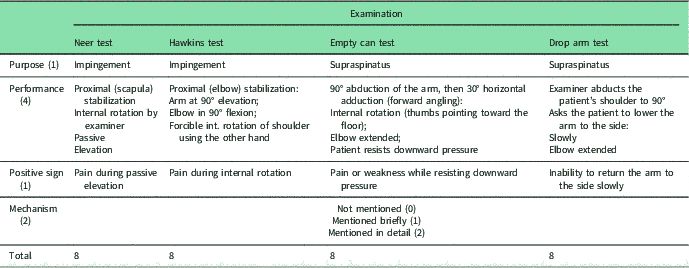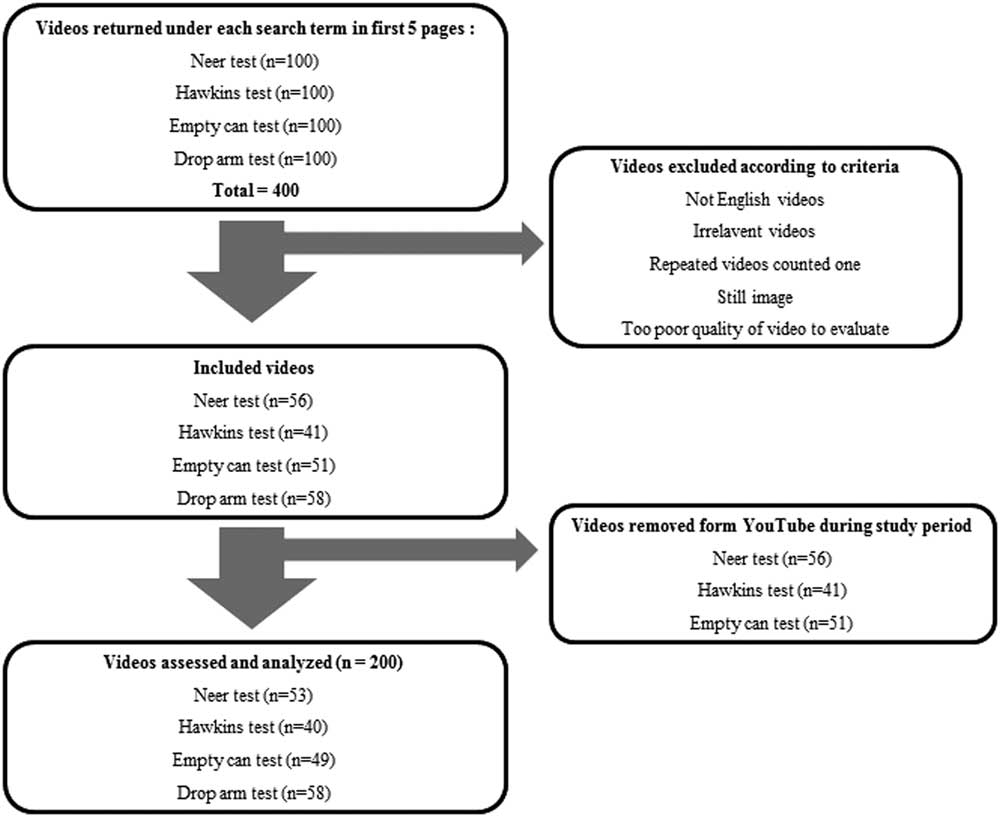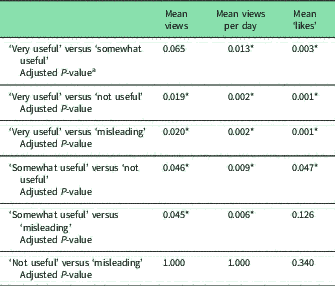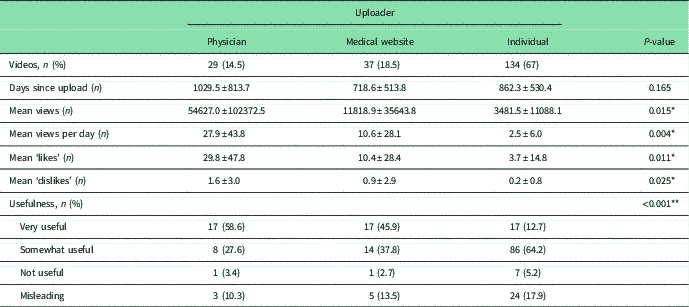Introduction
Through the development of the worldwide web, the internet has become the largest and the most up-to-date reservoir of medical information (Choules, Reference Choules2007). By taking advantage of its accessibility, e-learning has become an increasingly attractive method of medical education (Pusponegoro et al., Reference Pusponegoro, Soebadi and Surya2015). Thus, many medical students and doctors now use the internet as a learning tool (Muhammed et al., Reference Muhammed, Adcock and Sen2014).
Owing to the simplicity of providing online content, a large number of medical multimedia materials are available on the internet in a variety of formats. As virtual simulation is used before performing actual procedures on real patients, videos with three-dimensional (3D) images and audio are potentially excellent educational aids for manual procedures, such as physical examinations. Several previous authors have argued that video-based education improves learning outcomes among medical students. In a randomized, controlled, assessor-blinded trial, video instruction group of medical students significantly improved performance of venepuncture as measured by checklist score than non-video instruction group, with scores of 14.15 and 9.18, respectively, out of a total of 18 points (Pan et al., Reference Pan, Harcharik, Moskalenko, Luber, Bernardo and Levitt2014).
There are several open-access platforms, and YouTube is the second most popular website in the world following Google (www.google.com), accounting for 60% of all videos available online. Although similar websites such as Yahoo Video, MetaCafe, DropShots, and others are available for video sharing, the most popular video-hosting website is YouTube (www.youtube.com) (Azer et al., Reference Azer, Aleshaiwi, Algrain and Alkhelaif2012) and over 4 billion videos are watched around the world every day and more than 65 000 new videos are uploaded every day (Azer et al., Reference Azer, Algrain, AlKhelaif and AlEshaiwi2013). The true merit of this website is that it can be used to share medical education materials for free and can be accessed worldwide by medical students and doctors in training. However, YouTube is a consumer-generated website that is unregulated and thus carries the risk of disseminating inappropriate information.
Previous studies assessed the quality of YouTube videos as learning tools for electrocardiography (Akgun et al., Reference Akgun, Karabay, Kocabay, Kalayci, Oduncu, Guler, Pala and Kirma2014), respiratory auscultation (Sunderland et al., Reference Sunderland, Camm, Glover, Watts and Warwick2014), male urethral catheterization (Nason et al., Reference Nason, Kelly, Kelly, Burke, Aslam, Giri and Flood2015), tonic-clonic seizures (Muhammed et al., Reference Muhammed, Adcock and Sen2014), lumbar puncture, and neuroaxial block techniques (Rössler et al., Reference Rössler, Lahner, Schebesta, Chiari and Plöchl2012). Owing to the diverse quality of the content, they have been considered inadequate for educational use.
As physical examination is a procedure comprising movement in three dimensions, video examples can be extremely useful educational aids. Therefore, good-quality YouTube videos can be useful learning tools, with the added benefits of good accessibility and being cost-free. However, no study to-date has evaluated the validity of YouTube videos for shoulder physical examinations. This study aimed to investigate the usefulness of educational videos of shoulder physical examinations.
Numerous shoulder physical examinations are used to diagnose shoulder disorders. As performing all of them in each patient is not feasible, physical examination is often performed selectively. According to previous studies, rotator cuff injuries lead to a high prevalence of chronic shoulder disorders, which comprise 10% of all shoulder-related diseases, and the supraspinatus muscle is most commonly involved in rotator cuff tears. Shoulder impingement syndrome is also common, with five in 1000 individuals diagnosed as new clinical cases each year (Joo et al., Reference Joo, Lee, Shin, Lee, Kim, Koh, Park, Song, Cho and Ha2017). In this study, we selected four shoulder tests for each of the rotator cuff injuries and impingement syndromes. Other studies have shown that shoulder physical examinations have high sensitivity and are useful in clinical practice (Beaudreuil et al., Reference Beaudreuil, Nizard, Thomas, Peyre, Liotard, Boileau, Marc, Dromard, Steyer, Bardin, Orcel and Walch2009; Lange et al., Reference Lange, Matthijs, Jain, Schmitt, Lutzner and Kopkow2017).
The purpose of the present study was to assess the quality of YouTube videos as educational tools for four well-known physical examinations of the shoulder: the Neer, Hawkins, empty can, and drop arm tests.
Materials and methods
The Institutional Review Board of the Catholic University of Korea approved this study and exempted it from ethical review.
Search strategy
We selected four specific examinations of the shoulder: the Neer, Hawkins, empty can, and drop arm tests. Various search terms can be derived to find YouTube clips of these examinations. For example, searches for the Neer test can be performed using keywords such as ‘Neer’s sign test,’ ‘Neer impingement test,’ and ‘Neer test.’ Using Google Trends (http://www.google.com/trends/), we selected the following keywords, which were used most frequently to search for the physical examinations: ‘Neer test,’ ‘Hawkins test,’ ‘empty can test,’ and ‘drop arm test.’
After keyword selection, YouTube searches were conducted in March 2015 (‘Neer test,’ March 1, 2015; ‘Hawkins test,’ March 10, 2015; ‘empty can test’ and ‘drop arm test,’ March 11, 2015). The only search filter used was ‘relevance,’ which is the default filter for a normal YouTube search.
Using methods described previously (Nason et al., Reference Nason, Kelly, Kelly, Burke, Aslam, Giri and Flood2015), and with the baseline assumption that no user would go beyond the first five pages of results (20 videos per page) for each search term, videos on the first five pages were screened.
Inclusion and exclusion criteria
Only English-language videos were included in the search. Irrelevant videos and still images were excluded. Videos of sufficiently poor quality to prevent evaluation were also excluded. The same video reposted by multiple users was treated as a single video and evaluated once. For videos with content related to multiple shoulder examinations, only the sections of interest were evaluated.
Data assessment and review
Two physicians independently evaluated the videos and recorded characteristics including the date uploaded, the uploader, and the numbers of views, likes, and dislikes. Using these data, we calculated the number of days for which each video had been posted and the number of views per day. The upload sources were divided into three groups according to uploaders’ credentials: physicians, medical websites, and individuals. ‘Physician’ referred to an uploader based in an official hospital or professional organization, ‘medical website’ referred to an upload from a medical practitioner or unofficial hospital data, and ‘individual’ referred to an uploader of unknown credential (Kumar et al., Reference Kumar, Pandey, Venkatraman and Garg2014).
No standardized tool is available for the assessment of the quality of diagnostic information for shoulder examinations. To evaluate the quality of the videos, the authors scored the videos for each examination (Table 1), based on a review of the literature (Hermans et al., Reference Hermans, Luime, Meuffels, Reijman, Simel and Bierma-Zeinstra2013; Jain et al., Reference Jain, Wilcox, Katz and Higgins2013) and previous evaluations of YouTube videos (Akgun et al., Reference Akgun, Karabay, Kocabay, Kalayci, Oduncu, Guler, Pala and Kirma2014; Lee et al., Reference Lee, Seo and Hong2014; MacLeod et al., Reference MacLeod, Hoppe, Simunovic, Bhandari, Philippon and Ayeni2015). The scoring system had four components, each with a total possible score of 8: purpose, performance, positive sign, and mechanism. The scoring system contained checklists for each category, and the total number of points was calculated simply by summing the checked criteria. The maximum possible score was 8, and the minimum was 0. These scores were used to categorize videos into three groups: ‘very useful’ (6–8), ‘somewhat useful’ (3–5), and ‘not useful’ (0–2). Regardless of the score, videos containing incorrect information were classified as ‘misleading.’
Table 1 Customized scoring scheme

The assessors disagreed on the categorization of 22 videos (11% of the total), and consensus was reached after discussion.
Intra- and inter-rater reliability
The intra- and inter-rater reliability of the scoring system was assessed. Two physicians evaluated all videos and used a table of random numbers to randomly select five videos per examination for re-evaluation by one researcher two weeks after the initial assessment. Intra- and inter-rater reproducibility was assessed using the weighted kappa coefficient.
Statistical analysis
Data were analyzed with SPSS software (version 24; SPSS Inc., Chicago, IL, USA). Continuous variables were compared using one-way analysis of variance test with post-hoc analysis by Dunnett T3 test, and categorical variables were compared with Fisher’s exact test. Statistical significance was defined as P<0.05.
Results
A total of 100 videos from the first five pages of search results for each examination were reviewed in March 2015. After applying the exclusion criteria, a total of 206 videos were identified. Because six videos became inaccessible during the study period, a total of 200 videos were finally assessed and analyzed: 53 videos for the Neer test, 40 videos for the Hawkins test, 49 videos for the empty can test, and 58 videos for the drop arm test (Figure 1).

Figure 1 Flowchart of the selection process of videos
Usefulness of the videos
A total of 400 videos were evaluated and adopted 200 videos which yield eligible criteria. Out of 200 assessed videos, 51 (25.5%) videos were ‘very useful,’ 108 (54%) videos were ‘somewhat useful,’ and 32 (16%) videos were ‘misleading.’ Nine (4.5%) videos were categorized as ‘not useful.’
The video category was related significantly to viewers’ preferences, that is, views, views per day, and likes (Table 2). Post-hoc analysis (Table 3) revealed more views of ‘very useful’ videos than of ‘not useful’ and ‘misleading’ videos. ‘Somewhat useful’ videos also had more viewers than ‘not useful’ and ‘misleading’ videos. The number of views per day was generally similar, but differed significantly between the ‘very useful’ and ‘somewhat useful’ groups. The number of likes was larger for ‘very useful’ videos than for videos in the other groups, and for ‘somewhat useful’ videos compared with ‘not useful’ videos.
Table 2 Video demographics according to usefulness

*P<0.05.
Table 3 Post-hoc analysis of video demographics according to usefulness

a Adjusted P-values were used in pairwise comparisons by Dunnett’s T3 test.
*P<0.05.
Video demographics according to uploader are shown in Table 4. The majority (67%) of videos were uploaded by individuals, whereas only 14.5% were uploaded by physicians. The numbers of views, views per day, and likes were consistently smaller for videos uploaded by individuals than for those uploaded by physicians (P<0.05). Video usefulness was correlated significantly with the upload source (P<0.001). The proportion of ‘very useful’ videos was largest among those uploaded by physicians (58.6%) and smallest among those uploaded by individuals (12.7%). Videos uploaded by individuals accounted for a larger proportion of those with misleading content (17.9%) than did videos uploaded by physicians (10.3%; Table 4). Videos were analyzed based on the physical examination, and no significant difference in usefulness was observed among examinations (P=0.091; Table 5).
Table 4 Video demographics according to uploader

*P<0.05, physician versus individual.
**P<0.05, Fisher’s exact test.
Table 5 Video demographics according to examination

Intra- and inter-rater reliability
A weighted kappa score for intra-rater reliability was obtained by using 20 randomly selected videos, five for each of the four examinations (κ=0.847). Inter-rater reliability was calculated for each examination using a weighted kappa score; these values showed very good agreement (Neer test, κ=0.822; Hawkins test, κ=0.868; empty can test, κ=0.907; drop arm test, κ=0.854).
Discussion
YouTube provides a large number of easily accessible videos presenting shoulder physical examinations. It could be considered an extremely helpful educational tool for shoulder physical examinations if accurate clips were selected. This study is the first attempt to assess the quality of YouTube videos as educational tools for physical examinations of the shoulder.
Shoulder pain, the third most common musculoskeletal complaint among patients visiting physicians, has a substantial impact on quality of life (Hermans et al., Reference Hermans, Luime, Meuffels, Reijman, Simel and Bierma-Zeinstra2013). Appropriate physical examination is crucial in evaluating patients with shoulder pain because it has become a cornerstone of the diagnostic process (Hegedus et al., Reference Hegedus, Goode, Campbell, Morin, Tamaddoni, Moorman and Cook2008). To ensure the reliability of shoulder physical examinations, precise performance of the procedures is necessary. Multimedia sources can be more helpful than conventional texts for such manual procedures, as they can provide virtual images in the 3D plane with audio descriptions.
Many studies have attempted to determine the value of YouTube videos on a variety of medical topics as informational tools for medical students (Azer, Reference Azer2012; Azer et al., Reference Azer, Aleshaiwi, Algrain and Alkhelaif2012; Rössler et al., Reference Rössler, Lahner, Schebesta, Chiari and Plöchl2012; Muhammed et al., Reference Muhammed, Adcock and Sen2014; Lee et al., Reference Lee, Seo and Hong2015; Addar et al., Reference Addar, Marwan, Algarni and Berry2017) and patients (Sood et al., Reference Sood, Sarangi, Pandey and Murugiah2011; Singh et al., Reference Singh, Singh and Singh2012; Kumar et al., Reference Kumar, Pandey, Venkatraman and Garg2014; Lee et al., Reference Lee, Seo and Hong2014; Sorensen et al., Reference Sorensen, Pusz and Brietzke2014; MacLeod et al., Reference MacLeod, Hoppe, Simunovic, Bhandari, Philippon and Ayeni2015; Rittberg et al., Reference Rittberg, Dissanayake and Katz2016; Kwok et al., Reference Kwok, Singla, Phang and Lau2017; Cassidy et al., Reference Cassidy, Fitzgerald, Cassidy, Cleary, Byrne, Devitt and Baker2018). They have yielded negative results, due mainly to the variable quality of the videos.
Only 11% of YouTube clips that dealt with laparoscopic cholecystectomy training were rated as ‘good,’ whereas 30.1% were categorized as ‘poor’ (Lee et al., Reference Lee, Seo and Hong2015). Conversely, 27% of videos on surface anatomy (Azer, Reference Azer2012), 47% of videos on neurologic examination (Azer et al., Reference Azer, Aleshaiwi, Algrain and Alkhelaif2012), and 18% of videos on male urethral catheterization (Nason et al., Reference Nason, Kelly, Kelly, Burke, Aslam, Giri and Flood2015) were deemed useful.
Some studies have included additional information on misleading videos, which contain content that has not been proven scientifically. The information includes 16% of videos on electrocardiography (Akgun et al., Reference Akgun, Karabay, Kocabay, Kalayci, Oduncu, Guler, Pala and Kirma2014), 56% of videos on gallstone disease (Lee et al., Reference Lee, Seo and Hong2014), and 13% of videos on lumbar puncture and spinal anesthesia (Rössler et al., Reference Rössler, Lahner, Schebesta, Chiari and Plöchl2012) categorized as misleading. These findings imply that searchers risk accessing misleading videos when they select YouTube videos for educational purposes without using a screening process.
In analyzing viewers’ preferences, previous studies covering clips of electrocardiography, laparoscopic cholecystectomy, femoroacetabular impingement, and pediatric adenotonsillectomy and ear tube surgery revealed no significant relationship between usefulness and viewers’ responses, such as the numbers of views, likes, and dislikes (Akgun et al., Reference Akgun, Karabay, Kocabay, Kalayci, Oduncu, Guler, Pala and Kirma2014; Sorensen et al., Reference Sorensen, Pusz and Brietzke2014; Lee et al., Reference Lee, Seo and Hong2015; MacLeod et al., Reference MacLeod, Hoppe, Simunovic, Bhandari, Philippon and Ayeni2015). Moreover, in some studies pertaining to gallstone disease and hypertension, viewers displayed a preference for misleading videos (Kumar et al., Reference Kumar, Pandey, Venkatraman and Garg2014; Lee et al., Reference Lee, Seo and Hong2014).
In the present study, however, variables reflecting viewers’ preferences, such as the numbers of views and likes, were correlated significantly with video usefulness. Viewers’ preferences were also related directly to the upload source, with greater preference found for videos uploaded by professionals and medical websites than for those uploaded by individuals. These results are in disagreement with those of a previous study of videos related to gallstone disease, which showed a lack of correlation between viewers’ reactions and uploaders (Lee et al., Reference Lee, Seo and Hong2014).
Most (67%) videos assessed in this study were posted by individual users; physicians uploaded only 14.5% of videos. Whereas 58.6% of videos uploaded by physicians were very useful, this rate dropped to 12.7% for videos uploaded by individuals. Despite the relatively small proportion, videos uploaded by professionals had the highest quality. These results correspond to those of previous studies, which suggested that the upload source was a predictor of quality (Singh et al., Reference Singh, Singh and Singh2012; Akgun et al., Reference Akgun, Karabay, Kocabay, Kalayci, Oduncu, Guler, Pala and Kirma2014; Lee et al., Reference Lee, Seo and Hong2015; Madathil et al., Reference Madathil, Rivera-Rodriguez, Greenstein and Gramopadhye2015; Ajumobi et al., Reference Ajumobi, Malakouti, Bullen, Ahaneku and Lunsford2016).
In order for YouTube video to provide credibility as objectivity and accuracy, videos with a higher score could be considered to be of educational significance. Because approximately 87% of YouTube videos uploaded by individuals were included in the ‘somewhat useful,’ ‘not useful,’ or ‘misleading’ group, they were evaluated as less useful in the context of the educational value of YouTube videos. Considering that most of the videos are uploaded by individuals, it is important to select accurate videos by filtering system so that YouTube videos can be useful as educational tools.
Even those videos uploaded by the physicians may contain misleading content that can confuse novices. In the present study, ‘misleading’ videos accounted for around 1/6 of the total number of videos analyzed, and only three videos with misleading content were uploaded by physicians: one video for the empty can test and two videos for the drop arm test. Those videos also had titles that did not match the contents, raising the possibility of confusing the viewer with inappropriate knowledge of shoulder physical examinations. We also found less viewer preference for the three misleading videos uploaded by physicians than for useful videos uploaded by physicians. Some of the misleading videos uploaded by individuals and medical websites had inappropriate content, including practitioners’ demonstration of incorrect actions or ambiguous shoulder postures, and included video advertisements.
Considering our results, extra care should be taken when using YouTube clips. In this regard, filtering YouTube videos based on viewers’ preferences and the upload source can lead to the identification of reliable educational videos on shoulder physical examinations.
This study has a few limitations. First, no validated tool for the evaluation of video quality exists. We created a scoring system based on a review of the relevant literature, which was somewhat subjective and not validated. To ensure consistency, we assessed the scoring system by two physicians in the form of a checklist and obtained significant intra-rater and inter-rater agreement. Two reviewers would not be enough to prove the reliability. Second, this study was performed in a cross-sectional manner. The exclusion of six videos because of their disappearance during the study period highlights the temporary character of YouTube. YouTube is a dynamic repository of video information and search results may vary over time (Lee et al., Reference Lee, Seo and Hong2014). In addition, our analysis was limited to content located by direct searches on the YouTube site, and the results may not apply to videos accessed from directed links on other websites. And, non-English-language videos were excluded from the analysis.
In this study, significant relationships between video usefulness and viewers’ preferences were revealed. Video usefulness was also correlated with the upload source, with higher-quality content seen among clips uploaded by official hospitals and university-affiliated organizations.
YouTube could be used as an effective informational resource if an appropriate selection process is applied. Review of the upload source and viewers’ responses could help to identify higher-quality videos on shoulder physical examinations.








